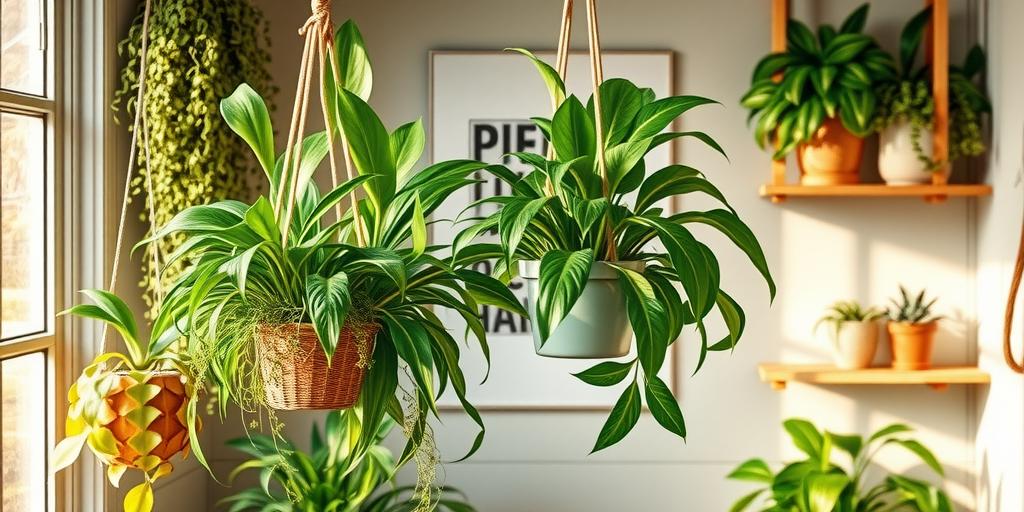
Best Hanging Plants for Low Light Bathrooms in 2025
Discover the best hanging plants for low light bathrooms in 2025! These easy-care, air-purifying plants thrive in humidity and dim spaces—perfect for your bathroom oasis.
Introduction
Did you know that certain plants can thrive even in the dimmest bathroom corners? If you’ve ever thought your bathroom was too dark for greenery, think again! Hanging plants are a fantastic way to add life, color, and fresh air to your space—without needing direct sunlight. In this guide, we’ll explore the top low-light hanging plants that love humidity, require minimal care, and transform your bathroom into a lush retreat. Let’s dive in!
Why Choose Hanging Plants for Low Light Bathrooms?
Benefits of Hanging Plants in Small or Dim Spaces
Hanging plants are a game-changer for bathrooms with limited natural light. Unlike floor plants, they don’t take up precious counter or floor space, making them ideal for compact bathrooms. Their trailing vines or cascading leaves add a lush, organic touch without overwhelming the room. Plus, many low-light hanging plants are naturally adaptable to dim conditions, so they won’t wither just because your bathroom lacks a sunny window.
How Humidity Helps Certain Plants Thrive
Bathrooms naturally have higher humidity levels, especially after showers or baths. Many tropical and low-light plants, like pothos and philodendrons, thrive in this environment because it mimics their native habitats. The extra moisture in the air reduces their need for frequent watering and keeps their leaves looking fresh and vibrant.
Space-Saving Advantages of Vertical Greenery
If your bathroom is on the smaller side, hanging plants are a smart way to maximize space. By growing vertically, they add greenery without cluttering surfaces. You can hang them from the ceiling, mount them on walls, or even drape them over shower rods—turning unused space into a mini indoor jungle.
Air-Purifying Qualities of Bathroom-Friendly Plants
Many hanging plants do more than just look pretty—they also help clean the air. Spider plants, for example, are known to remove toxins like formaldehyde and xylene. In a bathroom, where ventilation can sometimes be an issue, having air-purifying plants can contribute to a fresher, healthier environment.
Top Low-Light Hanging Plants for Bathrooms
Pothos (Epipremnum aureum) – Nearly Indestructible, Thrives in Low Light, and Trails Beautifully
Pothos is a classic choice for low-light bathrooms because it’s incredibly forgiving. Whether your bathroom gets minimal natural light or just artificial lighting, this plant will still grow steadily. Its long vines can trail several feet, making it perfect for hanging baskets. Plus, it comes in different varieties, like golden pothos or marble queen, so you can pick one that matches your décor.
Spider Plant (Chlorophytum comosum) – Purifies Air, Loves Humidity, and Produces Cute Offshoots
Spider plants are another excellent option for bathrooms. They’re known for their air-purifying abilities and their ability to thrive in indirect light. They also produce “pups” (small offshoots) that dangle from the mother plant, adding a playful touch. The humidity in bathrooms helps keep their leaves from browning at the tips, a common issue in drier spaces.
Philodendron Heartleaf (Philodendron hederaceum) – Fast-Growing, Adaptable, and Perfect for Hanging Baskets
With its heart-shaped leaves and trailing vines, the heartleaf philodendron is a charming addition to any bathroom. It grows quickly, even in low light, and its vines can be trained to climb or left to cascade. It’s also very low-maintenance—just water when the top inch of soil feels dry.
String of Pearls (Senecio rowleyanus) – Unique Cascading Succulent That Tolerates Low Light
If you want something a little more unusual, the string of pearls is a great pick. This succulent has trailing stems adorned with small, bead-like leaves. While most succulents prefer bright light, this one can handle lower light conditions, especially in a humid bathroom. Just be careful not to overwater it—let the soil dry out between waterings.
Peperomia (Peperomia spp.) – Compact, Colorful Foliage With Low Maintenance Needs
Peperomias come in many varieties, from the watermelon peperomia with its striped leaves to the trailing peperomia hope. They’re compact, making them great for small bathrooms, and their thick leaves help them retain moisture. They don’t need much light to thrive, and their colorful foliage adds a nice pop of texture to your space.
Care Tips for Hanging Plants in Low Light
Watering Frequency—How to Avoid Overwatering
One of the biggest mistakes with bathroom plants is overwatering. Since bathrooms are humid, the soil takes longer to dry out. Always check the soil before watering—stick your finger an inch deep. If it’s dry, water thoroughly; if it’s still moist, wait a few more days. Plants like pothos and philodendrons prefer slightly dry soil between waterings, while spider plants like consistent moisture.
Best Soil Types for Moisture Retention
Using the right soil mix is key. For most hanging plants, a well-draining potting mix with some perlite or orchid bark works well. If your bathroom is extra humid, adding a bit of extra perlite can prevent the soil from staying soggy. For succulents like string of pearls, a cactus or succulent mix is best to avoid root rot.
Pruning and Maintenance for Healthy Growth
Regular pruning keeps your hanging plants looking full and prevents leggy growth. Trim back any yellow or dead leaves, and pinch off the tips of vines to encourage bushier growth. Spider plants may need occasional grooming to remove brown tips, and pothos can be trimmed to control their length.
Signs Your Plant Needs More (or Less) Light
Even low-light plants need some indirect light to thrive. If your plant’s leaves are turning pale or stretching toward the light, it might need a slightly brighter spot. On the other hand, if the leaves are scorched or crispy, it could be getting too much direct sunlight. Adjust its position gradually to avoid shocking the plant.
Styling Ideas for Hanging Plants in Bathrooms
Creative Ways to Hang Plants (Macramé, Hooks, Shelves)
Hanging plants can be displayed in so many stylish ways. Macramé hangers add a bohemian vibe, while sleek ceiling hooks give a modern look. Floating shelves can hold multiple small plants, and tension rods in showers can support trailing vines. Just make sure whatever you use can handle the weight of the plant and pot.
Pairing Plants for Visual Appeal
Mixing different textures and colors creates a dynamic display. Try pairing a pothos with a spider plant for contrasting leaf shapes, or combine a string of pearls with a peperomia for varied foliage. Grouping plants at different heights also adds depth to your bathroom’s décor.
Using Trailing Plants as Natural Décor Accents
Let your plants’ natural beauty shine by allowing them to cascade freely. A pothos or philodendron draped over a mirror or shelf softens hard edges, while a string of pearls spilling out of a wall-mounted planter adds whimsy.
Best Spots in the Bathroom for Optimal Growth
The best placement depends on your bathroom’s layout. Near a frosted window is ideal for filtered light, but if your bathroom is windowless, a spot near artificial light works too. Avoid placing plants directly above heat sources like radiators, which can dry them out.
Common Problems & Solutions
Yellowing Leaves and How to Fix Them
Yellow leaves usually signal overwatering or poor drainage. Check the soil—if it’s soggy, let it dry out and consider repotting with better-draining soil. If the plant is root-bound, it may also need a larger pot.
Pest Prevention in Humid Environments
High humidity can attract pests like fungus gnats or spider mites. Keep the area well-ventilated, and avoid letting water sit in saucers. Neem oil or insecticidal soap can help treat minor infestations.
Reviving a Struggling Plant
If a plant looks wilted or droopy, assess its care routine. Trim dead growth, adjust watering, and check for pests. Sometimes, moving it to a slightly brighter spot can help it recover.
When to Repot for Better Growth
Most hanging plants need repotting every 1-2 years. Signs it’s time include roots growing out of drainage holes, slowed growth, or soil that dries out too quickly. Choose a pot just one size larger to prevent overwatering issues.
Conclusion
Transforming your low-light bathroom into a green paradise is easier than you think! With the right hanging plants—like pothos, spider plants, and philodendrons—you can enjoy lush, air-purifying foliage without needing bright sunlight. Whether you’re a plant newbie or a seasoned green thumb, these low-maintenance options will thrive in your bathroom’s unique conditions. Ready to elevate your space? Pick your favorite plant and start hanging today!
